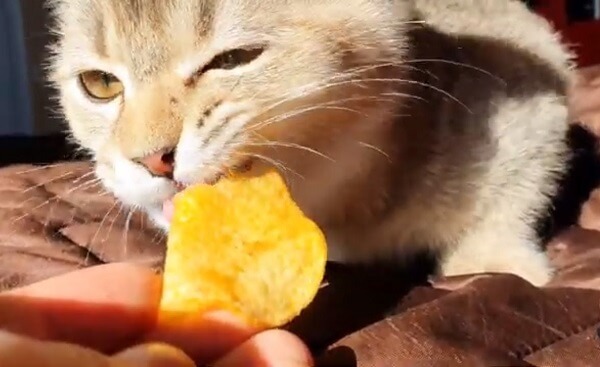Can Cats Eat Catnip? A Comprehensive Guide For Cat Owners
Did you know that catnip can induce a euphoric state in cats, but not all felines react similarly?
Catnip, scientifically known as Nepeta cataria, is a herbaceous plant from the mint family. It contains a compound called nepetalactone, which triggers a response in many cats, often leading to behaviours like rolling, rubbing, and increased vocalization. However, not all cats are affected by catnip, as sensitivity to it is hereditary, and approximately 30-50% of cats show no response.
Contents
Can Cats Eat Catnip?
Yes, cats can eat catnip safely. The active compound, nepetalactone, triggers playful behavior and excitement when smelled or ingested. Although non-toxic, consuming too much catnip may lead to mild stomach upset. Always offer in moderation.
Is Catnip Safe for My Cat?
Catnip can be offered to cats in various forms, including dried leaves, sprays, and toys infused with catnip oil. It’s generally considered safe for cats to ingest tiny amounts of catnip by eating the leaves directly or through scented toys. Consuming catnip can result in a temporary behaviour change, often characterized by excitement followed by a period of calmness.
While catnip is non-toxic to cats, overindulgence may lead to gastrointestinal upset, such as vomiting or diarrhoea. Therefore, offering catnip in moderation is advisable, particularly if your cat is strongly attracted to it.
Related: Can Cats Eat Avocado?
What happens if a cat eats catnip?
When a cat eats catnip, it usually experiences a calming effect. The active compound, nepetalactone, interacts with the cat’s sensory neurons, often leading to relaxed or drowsy behavior. Overconsumption may result in mild digestive upset.
Do cats eat catnip or just smell it?
Cats both smell and eat catnip. When sniffed, catnip triggers a euphoric, playful response, while ingesting it tends to have a calming effect. Some cats prefer one method over the other, showcasing varying reactions.
Is it OK for cats to drink catnip?
Yes, it’s safe for cats to drink catnip tea or water infused with catnip, provided it’s given in small amounts. Drinking catnip can promote relaxation and stress relief, making it useful for calming anxious cats.
What exactly does catnip do to cats?
Catnip stimulates a cat’s sensory receptors through its active compound, nepetalactone. This can induce playful, hyperactive behavior or a calming effect, depending on how it’s consumed. Reactions vary, with some cats becoming energetic while others relax.
Conclusion:
In conclusion, catnip can be a fun and enriching addition to your cat’s life, but it’s essential to offer it in moderation and monitor your cat’s reaction. If your cat shows no interest in catnip, don’t worry—it’s perfectly normal, as not all cats are responsive to its effects. As with any treatment or enrichment activity, always prioritize your cat’s safety and well-being.
NOTE: Always check with your veterinarian first before giving your cat any new foods, especially “people foods.” What might be okay for one cat might not be suitable for your cat, depending on multiple factors, such as their age, health history, health conditions, and diet. Cats on prescription diets should not be fed any food or treats outside the diet.
FAQs about Cats and Catnip
Q: Can all cats eat catnip?
A: No, not all cats are affected by catnip. Approximately 30-50% of cats do not respond to catnip due to a genetic factor. Sensitivity to catnip is hereditary, so if one of a cat’s parents does not react to catnip, it’s likely their offspring won’t either.
Q: What are the effects of catnip on cats?
A: Catnip contains nepetalactone, which can induce a range of cat behaviours, including rolling, rubbing, increased vocalization, and hyperactivity. After the initial excitement, cats may experience a period of calmness or relaxation.
Q: Is catnip safe for cats to eat?
A: Catnip is generally safe for cats to eat in small amounts. However, overconsumption can lead to gastrointestinal upset, such as vomiting or diarrhoea. It’s essential to monitor your cat’s intake of catnip and offer it in moderation.
Q: How can I give catnip to my cat?
A: Catnip can be offered to cats in various forms, including dried leaves, catnip-infused toys, and catnip sprays. You can sprinkle dried catnip on scratching posts, toys, or bedding or offer catnip-infused toys for your cat to play with.
Q: How often can I give catnip to my cat?
A: It’s recommended to offer catnip to your cat no more than once every few days to prevent desensitization. Giving catnip too frequently may reduce its effectiveness over time. Additionally, monitor your cat’s reaction and adjust the frequency accordingly.
Q: Why do some cats not respond to catnip?
A: Sensitivity to catnip is hereditary, so if a cat does not respond, it’s likely due to genetics. Cats with a specific genetic makeup lack the receptors to detect the nepetalactone compound in catnip, resulting in no observable reaction.
Q: Are there any alternatives to catnip for cats who don’t respond to it?
A: Yes, some alternative plants and herbs, such as silver vine, valerian root, and honeysuckle, may elicit similar responses in cats. Experimenting with different spices and plants can help find alternatives for cats that do not react to catnip. However, as with catnip, monitoring your cat’s reaction and offering these alternatives in moderation is essential.
- Golden Retriever Pros and Cons: What Every Pet Parent Should Know - 15 September 2025
- Cane Corso Dog Breed: Health, Care, and Lifespan - 14 September 2025
- Catahoula Leopard Dogs: Description, Temperament, Lifespan, & Facts - 21 July 2025







